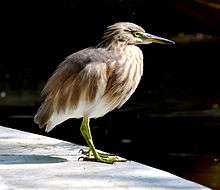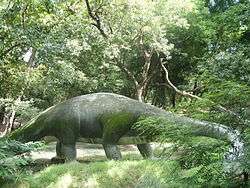Allen Forest Zoo
|
Life sized sculpted dinosaur | |
| Date opened | 4 February 1974[1] |
|---|---|
| Location | Kanpur, Uttar Pradesh, India |
| Coordinates | 26°30′10″N 80°18′13″E / 26.502886°N 80.303643°ECoordinates: 26°30′10″N 80°18′13″E / 26.502886°N 80.303643°E |
| Land area | 77 ha (190 acres)[1] |
| Major exhibits | Animals, Insects and Aquatic animals |
| Website |
forest |
Kanpur Zoo (Hindi: कानपुर चिड़ियाघर / कानपुर प्राणी उद्यान, also called the Allen Forest Zoo) is a 77-hectare (190-acre) zoo in Kanpur, the industrial hub of Uttar Pradesh in North India. It is the largest open green space in Kanpur. Originally a natural habitat for fauna, it is one of the few zoos in India created in a natural forest.
Location and hours
The Allen Forest Zoo is located about two kilometers (1.2 miles) from the city’s center.[2] In earlier colonial records, it is mentioned as being close to Nawabganj, a locality in Kanpur. The zoo is an oasis of green, featuring a natural lake and ancient trees, and encompasses the largest land area of any zoological garden in Asia.
The zoo is open for visitors on all days from 9 am to 4:30 pm, except on Mondays. Given its vast size, private four-wheeler vehicles are not allowed inside of the zoo. Two Electric cars are available on payment of rs.30 per person or rs. 210 for a 50 mins ride. Plastic bags are strictly banned inside of the zoo, and water is provided in coolers instead of in plastic bottles. Water, snacks and ice cream is available in plenty.
History
The Zoological Park in Kanpur, (Cawnpore), (known as the Manchester of Asia in the British colonial period) was the brainchild of a botanist Sir Allen, a member of the British Indian Civil Service. Sir Allen wanted to open the zoo in a natural forest, but his plans were stuck in bureaucratic red-tape and did not materialize. When the zoo at last opened in 1971 by the government of independent India, it was named after him.
Allen forest was developed during the British rule between the years 1913-1918 by George Burney Allen, a famous British industrialist of Kanpur on the banks of the river Ganges. The zoo was constructed from 1971-1973. The first animal to arrive at the zoo was an otter caught by a fisherman from the Chambal River.
In 1975, the first appointed doctor of the zoo was Dr. Ashwani Kumar Tripathi, who graduated from the G. B. Pant University of Agriculture and Technology, College of Veterinary & Animal Sciences. Dr. Tripathi contributed to efforts in introducing modern technology to keep the animals healthy. The enclosures for animals and birds were designed on the latest trends in the field of zoo building technology, well spread along the lake on either side of a semicircular arterial road of about 9 km. length.
The current director of the zoo is Mr Mukesh Kumar (1987 Batch,IFS )
Animals
Mammals at the zoo include white Asian tigers, cheetah, leopard, jaguar, hyena, black bear, grizzly bear, sloth, rhinoceros, hippopotamus, monkeys, langur, baboons, musk deer, deer, zebra, and antelope.[2] chimpanzees (including a 26-year-old named Chhajju) and orangutans (including a 30-year-old named Mangal) have their own island. Some monkeys and deer are allowed to roam outside the enclosures as natural inhabitants of the zoo.
Amphibians at the zoo include Indian gharial.
The lion at the zoo died of an unknown disease during November 2010. It is currently under consideration whether a current animal will be exchanged for a lion from a different zoo.

Attractions
Botanical garden
The zoo houses a botanical garden with a collection of some of the country’s rare species of plants that is dotted with sylvan lakes. The zoo grounds are also professionally maintained by forest conservationists, and it records large attendance from all age groups and communities in Kanpur. It is a popular destination for picnics, nature walks, and outdoor recreation, as well as teaching school students about natural habitats, environmental issues, and responsible eco-friendly living.
Lake
A rainwater lake is the centre of attraction at Allen Forest, and visitors can see hundreds of deer grazing in open savannah-like land without fear of any predator.
Aviary
The Aviary includes birds from all over the world, including parrots, cranes, parakeets, African ostriches, emus from Australia and New Zealand, various Indian birds, as well as birds from Europe and Latin America.
Night house
Night creatures are housed in a separate building. These include porcupines, toddy cats (Asian palm civet), and other nocturnal animals.
Aquarium
The zoo includes an aquarium.
Life size dinosaur sculptures
There are life size sculptures of pre-historic dinosaurs.
Toy train
The Allen Forest will soon have a toy train in place for which railway station and tracks are being laid at the zoo. However, project will be a valuable addition to the zoo but as a cost the forest will have to suffer a huge loss of greenery.[3]
Conservation
The zoo includes a veterinary hospital that treats up to 1,400 animals at a time, including hyenas, jaguars, and elephants that are brought into the zoo, usually after bad encounters with humans.[4]
Vehicles are allowed inside the zoo, but there is extra charge for this. Plastic water bottles and polythene bags are banned inside the park. Although photography is permitted, the zoo discourages visitors from feeding animals except in designated areas.
Sponsors
The zoo authorities encourage local Kanpur and Uttar Pradesh based industrialists to take interest in the development and preservation of the ecological heritage of the Kanpur Zoo and its potential for development as a rare natural habitat based zoo.
References
| Wikimedia Commons has media related to Kanpur Zoo. |
- 1 2 "About us". Forest.up.nic.in. Kanpur Zoological Park. Retrieved 17 February 2013.
- 1 2 "Allen Forest Zoo". Mapsofindia.com. Maps of India. Retrieved 3 October 2010.
- ↑ Toy train in Kanpur zoo at the cost of zoo's greenery is not acceptable, say nature lovers, The Times of India, 21 August 2013
- ↑ Malhotra, Abhina (15 May 2010). "Kanpur zoo playing saviour for injured wild animals". Timesofindia.indiatimes.com. Times of India. Retrieved 3 October 2010.
